Types of Thorny Bushes and Vines (With Pictures and Names) – Identification

Thorny bushes and shrubs are ideal security plants to protect your property from unwelcoming visitors. Prickly plants with thorns provide a natural defensive barrier around your property without spoiling your garden’s aesthetics. Additionally, evergreen shrubs with thorns also offer all-year round privacy thanks to their dense foliage, spines, prickles, and thorns.
The best thorny bushes for creating an impenetrable barrier should have strong or stiff spines or spikes. You can choose flowering shrubs with thorns on the stems, plants with jaggy leaves, or prickly plants with berries. Rather than make your yard look like a maximum-security complex, spiky plants complement your garden’s landscape.
This article is a guide to growing thorny plants in your garden for their decorative appeal or protective characteristics to deter intruders.
What Are Thorny Bushes
Thorny bushes are prickly or spiky plants that make ideal privacy hedges or living screens. Growing thorny plants as a yard barrier can deter humans or animals from entering your property. In addition, many ornamental shrubs have long, sharp spines—so they are visually appealing and provide a practical security solution.
Deciduous perennial prickly bushes have plenty of ornamental appeal because they usually flower. In addition, evergreen shrubs with thorns are excellent as a defensive hedge and noise barrier throughout the year. Whatever type of natural security hedge you plant, a row of thorn bushes looks better than razor wire or other types of security fences.
Why Plant Thorny Bushes as Defensive Plants
Tall spiky plants around your yard’s perimeter are the ultimate deterrent. Not only do spiky security plants deter would-be burglars, but they also keep out unwanted wildlife. For example, it’s not always practical to erect tall fences to deer-proof your garden. Or other plant-eating pests such as rabbits get through small gaps in walls and fences. However, they will struggle to get through a hedgerow of defensive plants without injury.
Using thorny bushes for living fences won’t allow unwanted wildlife to venture through or over the hedge.
Where to Grow Prickly Plants and Thorny Shrubs
Growing prickly shrubs and thorny plants requires some thought as to where to plant them. It is best to leave some space between the spiked bushes and pathways or around your lawn. After all, you don’t want kids or pets to injure themselves on sharp, vicious shrub spines.
Here are a few ideas on where to grow thorny plants for their defensive characteristics:
- Use thorny foundation plantings under windows to prevent burglars from getting unlawful entry to your home.
- A row of tall spiky plants or flowering shrubs with thorns growing along a wall or fence can deter unwanted guests.
- Rather than erect a fence, grow thorn bushes in strategic places to keep out deer, cats, stray dogs, rabbits, raccoons, and other pests.
Other Benefits of Thorny Bushes in Your Garden
Planting thorny perimeter hedges along fences, walls, and your property have more benefits than just a defensive mechanism. A spiky living hedge is easier to maintain than repairing a damaged fence. Apart from pruning once a year, a low-maintenance thorn bush needs little care to grow well.
Thorny bushes can be planted to create seasonal interest and attractive landscape features. Flowering prickly hedge plants bloom in shades of red, purple, white, orange, pink, and yellow. Thorny shrubs also act as natural windbreaks, noise barriers, and habitats for beneficial animals and insects.
How to Handle Thorny Shrubs and Spiky Plants
Growing spiky shrubs and thorny plants in your garden requires great care. Prickly bushes can have long, stiff, sharp, vicious-looking spines that can puncture the skin. Also, some defensive plants have irritants in their thorns. So, it’s always wise to use protective gear when handling a thorn bush.
Before pruning, replanting, or working with a thorny plant, use puncture-resistant gloves to avoid damage to your hands. It’s also a good idea to wear goggles when pruning branches with thorns. Additionally, boots with thick soles can prevent stepping on sharp spines.
How to Identify Bushes with Thorns
Thorny growth on shrubs can help identify the species of ornamental plants. Shrub identification is often done by looking to see if the plant has thorns or spines on the stem. However, if you want to accurately identify a shrub, you will need to check other identifying features, such as looking at the leaves, growth habits, size, flowers, and fruit.
Types of Thorny Bushes (With Pictures)
Let’s look in more detail at the different types of thorn bushes you can grow as security bushes or defensive plants.
Thorny Bougainvillea Bushes and Vines
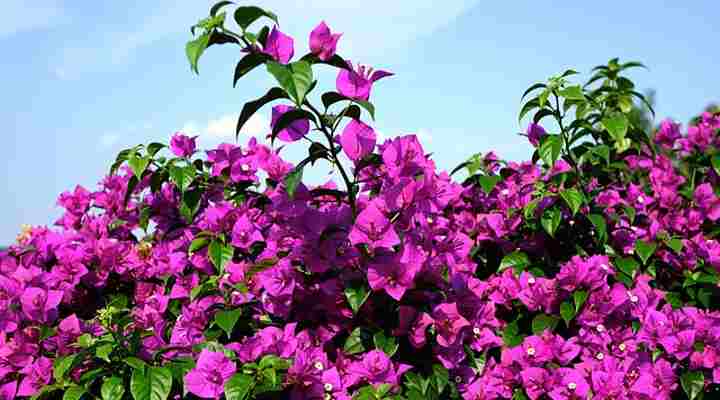
Bougainvillea thorn bush flowers come in a wide array of colors
Bougainvillea is a spectacular evergreen flowering vine with long arching thorny branches. A thorny bougainvillea vine is ideal for protecting walls or fences to prevent people from climbing over. The spreading vine grows up to 24 ft. (12 m) tall, and the thorny stems attach to structures or plants. Bougainvillea is suitable for growing in USDA zones 9 and 10.
Bougainvillea vines are popular in warm climates in Florida, South Carolina, and Mediterranean countries. It’s an attractive drought-tolerant plant and grows along fences, in containers, or hanging baskets.
Identify bougainvillea vines and bushes by their heart-shaped leaves, papery showy flowers, and sharp spikes growing on branches.
Grow bougainvillea in warm climates of USDA zones 9 – 11 and full sun.
Crown of Thorn Plants (Euphorbia milii)
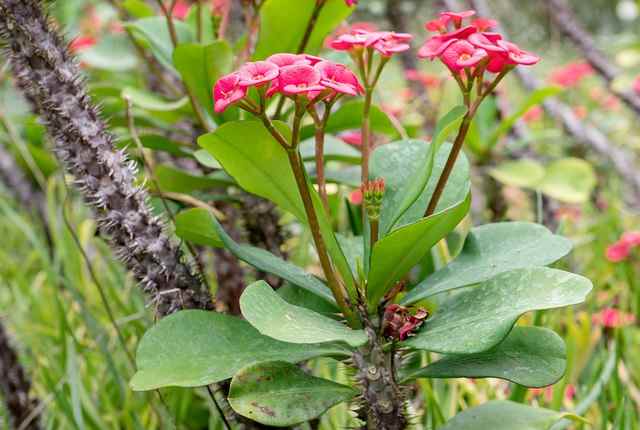
Euphorbia milii is a flowering shrub with thorns on its thick stems
The crown of thorn plant is a medium-sized flowering shrub with spines. The woody shrub is identified by its long-lasting round red or pink bract flowers and bright green leaves. As a security bush, the shrub has sharp spines growing up to 1” (2.5 cm) long on thick stems.
Also called the Christ plant or Christ thorn, the jaggy stems also ooze a mildly toxic white sap. Crown of thorns grows between 5 and 6 ft. (1.5 – 1.8 m) tall. It grows best in full sun and is suitable as a defensive garden plant in zones 9 through 11.
Identify a crown of thorn plant by its bright green leaves, colorful bracts, and thick spiny stems growing in a zig-zag shape.
Thorny Firethorn Shrub (Pyracantha)
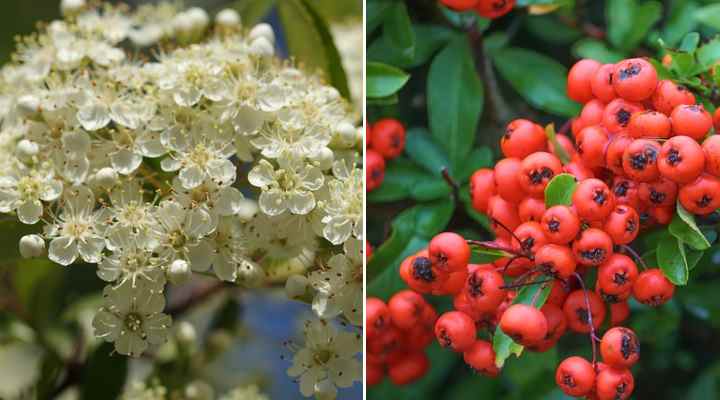
Thorny firethorn shrub can be identified by its white flowers in late spring to early summer and berry-like fruit that matures in late autumn
The firethorn bush is a tall evergreen thorny hedge plant with small green oval leaves, clusters of white flowers, and berries that can be red, orange or yellow. Its dense thorny structure means that the spiky shrub is suitable for protecting borders, growing as a defensive hedge, or as a specimen plant. Firethorn shrubs grow 6 to 16 ft. (1.8 – 5 m) tall.
The firethorn looks like a cotoneaster plant due to its clusters of red berries. However, unlike the ground cover cotoneaster shrub, firethorn has numerous thorns along its stems. Suitable for growing in USDA zones 6 through 9 in full sun to partial shade.
Identify firethorn shrubs by their white flowers, elongated shiny green leaves, red berries, and sharp thorns.
Thorny Rose Shrub (Rosa rugosa)
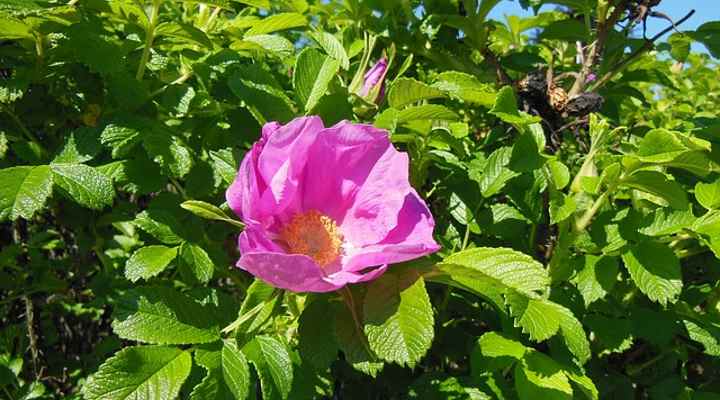
Thorny rose is an ornamental flowering shrub with many cultivars
Thorny rose shrubs are beautiful flowering shrubs with plentiful sharp thorns growing on woody canes. Shrub roses are prickly, spreading shrubs that grow in many types of soils. Shrub roses bloom with attractive pink flowers followed by large orange rose-hip fruits. Thorny rose shrubs grow between 4 and 6 ft. (1.2 – 1.8 m) tall and up to 6 ft. (1.8 m) wide.
Identify thorny rose shrubs by their attractive, showy pink blossoms, rich green foliage, and abundance of small sharp thorns on the branches.
Grow thorny rose shrubs in USDA zones 3 – 8. This shrub grows best in full sun to partial shade.
Agarita (Mahonia trifoliolata)
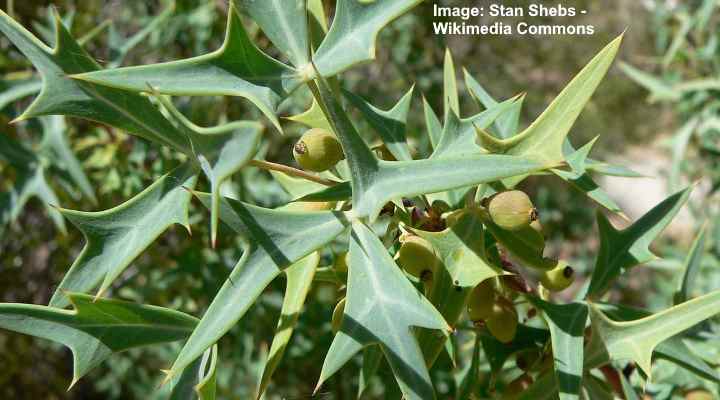
Agarita is a spiky plant with prickly leaves, yellow flowers and red berry-like fruit
Agarita is an evergreen shrub with red berries and jagged, holly-like leaves. The rounded spreading growth of agarita shrubs, gray-green foliage, small yellow cup-shaped flowers, and red berries give the prickly shrub plenty of ornamental value. Agarita shrubs grow between 2 and 6 ft. (0.6 – 1.8 m) tall and wide.
Agarita shrubs thrive in full sun to partial shade in USDA zones 7 through 9. Plant the spreading defensive medium-sized shrub as foundations plantings, border plants, or to protect banks and slopes. In some states, agarita is considered an invasive plant.
Identify agarita shrubs by their leaves consisting of three prickly leaflets, clusters of yellow flowers, and edible red berries.
Japanese Barberry (Berberis thunbergii)
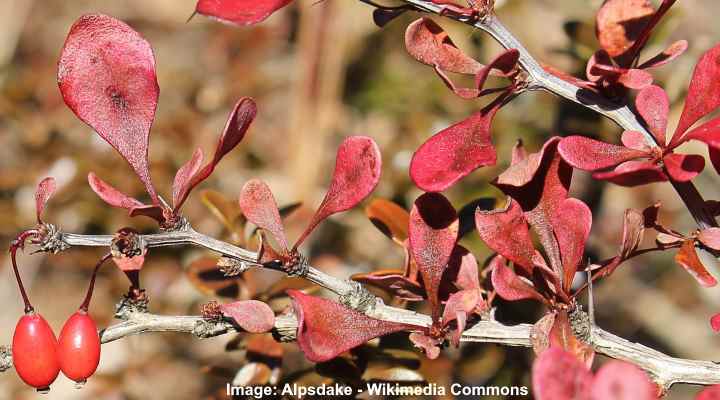
Japanese barberry is a prickly bush with colorful leaves that can be grown as security hedge
Japanese barberry is a spiky hedge plant with tiny oval leaves, yellow flowers, small sharp spines, and red berries. Also called Thunberg’s barberry or red barberry, this prickly plant has spines growing at leaf nodes. The barberry grows between 3 and 6 ft. (1 – 1.8 m) tall and spreads to 7 ft. (2.1 m) wide.
The purple Japanese barberry (Berberis thunbergii f. atropurpurea) is a purple-leaved thorny shrub.
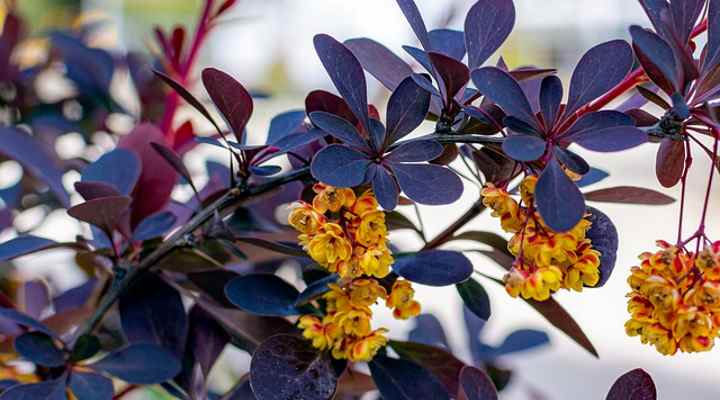
Berberis thunbergii f. atropurpurea
Japanese barberry is an excellent defensive plant as a foundation planting, protective hedge or screen, or growing along a fence. The colorful foliage, clusters of red berries, and bushy nature give this ornamental bush seasonal interest throughout the year in USDA zones 4 to 8 in sunny or partial-shady areas.
Identify Japanese barberry by its densely growing spiny branches, clusters of drooping yellow flowers, and bright shiny red berries.
Chinese Quince (Chaenomeles speciosa)

The thorny Chinese quince bush is a decorative spiky plant with attractive flowers and edible fruit
Flowering Chinese quince is a deciduous multi-stemmed shrub with thorny woody branches, pinkish-white or red flowers, and edible apple-like fruits. Quince shrubs bloom in early spring on bare jagged stems. The deciduous oblong leaves turn deep red in the fall, revealing large spines on branches.
Chinese quince grows in USDA zones 4 through 8 and thrives in full sun and well-drained ground. Its dense prickly branches mean that Chinese quince is ideal as a security hedge, privacy screen, or protective property barrier.
Identify Chinese quince by its masses of red or pink 5-petaled flowers, dense growth, spiny branches, and tart edible fruit.
Sea Buckthorn (Hippophae rhamnoides)
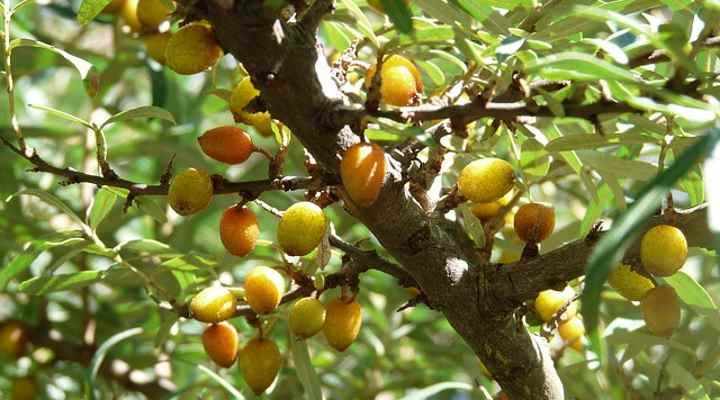
Sea buckthorn is a cold hardy low-maintenance deciduous prickly bush that grows in sun or partial shade
Sea buckthorn is a cold-hardy deciduous shrub with thorny branches, silver-green linear leaves, and bright orange or yellow berries. Sea buckthorn grows between 8 and 12 ft. (2.4 – 3.6 m) tall and wide. The multi-stemmed shrub has masses of orangey-yellow berries that persist until winter, adding to the shrub’s ornamental interest.
The tall nature of sea buckthorn and rounded, dense growth makes it suitable for a wind break, security screen, or mass planting along borders.
Identify sea buckthorn by its silvery-green thin lanceolate leaves, sharp, stiff spines, and orange clusters of healthy berries.
Common Hawthorn Spiky Shrub (Crataegus monogyna)
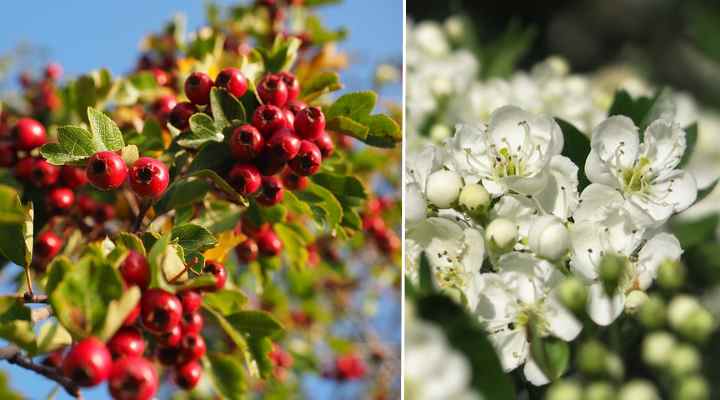
Common hawthorn is a prickly shrub with attractive white flowers and red fruit
Common hawthorn is a flowering shrub or small tree with thorny branches. The features of the hawthorn that make it an excellent defensive hedge are its densely growing branches, sharp 1” (2.5 cm) thorns, and low maintenance. Spiky hawthorn shrubs grow between 15 and 45 ft. (5 – 14 m) tall.
Also called oneseed hawthorn, maythorn, or quickthorn, the prickly shrub thrives in USDA zones 5 to 7. In full to partial sun, hawthorn produces sprays of creamy-white flowers and red fruits.
Identify the common hawthorn shrub by its small lobed leaves, fragrant clusters of white flowers, and red fall fruits.
Related reading: Beautiful types of hawthorn trees.
Spiky Blackberry Shrub (Rubus fruticosus)
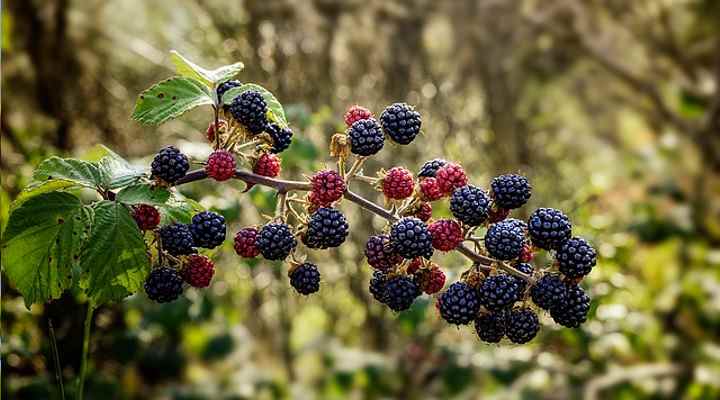
Blackberry shrub is a deciduous flowering spiky plant with very prickly woody stems
Blackberry shrubs are hardy defensive plants with long, arching, thorny stems that produce masses of blackberries. Depending on the climate, scrambling blackberry shrubs have evergreen or deciduous leaves. Five-petaled flowers bloom in spring before maturing into edible berries.
Grow blackberry shrubs as a security hedgerow or defensive ground cover plant for full sun. The spreading jagged canes can grow up to 6.5 ft. (2 m) high. Grow in USDA zones 3 through 8 in full sun.
Identify blackberry shrubs by their spiky branches, clusters of pinkish-white flowers, and small leaves with serrated margins.
Common Holly (Ilex aquifolium)
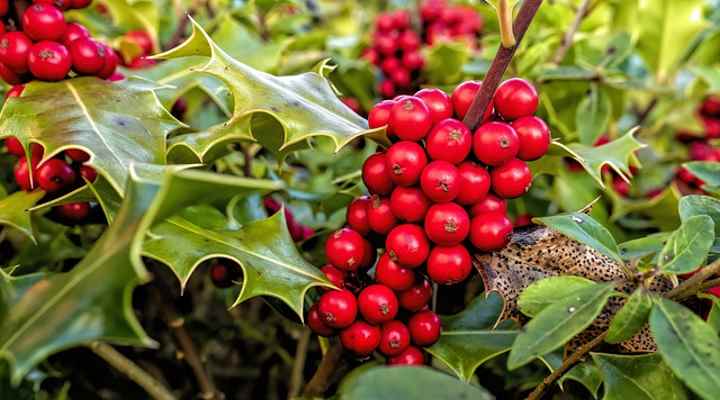
The common holly is an evergreen spiky leafy plant with red berries that is popular in many gardens
Common holly is an evergreen hedge shrub with sharp, prickly leaves and red berries. The defensive characteristic of holly shrubs is their spiny leaves that don’t allow animals to get through the foliage. Holly shrubs typically grow 7 to 10 ft. (2.1 – 3 m) tall and wide.
Grow prickly holly plants in USDA zones 6 to 10 in full or partial sun. The shrub is ideal as a tall perimeter security hedge, pruned as a foundation planting, or along a fence to protect it. The thick jaggy foliage is deer and rabbit resistant.
Identify the common holly shrub by its thorny leaves with wavy edges, abundant clusters of small white flowers, and glossy red berries that persist until winter.
Spiked Blackthorn (Prunus spinosa)
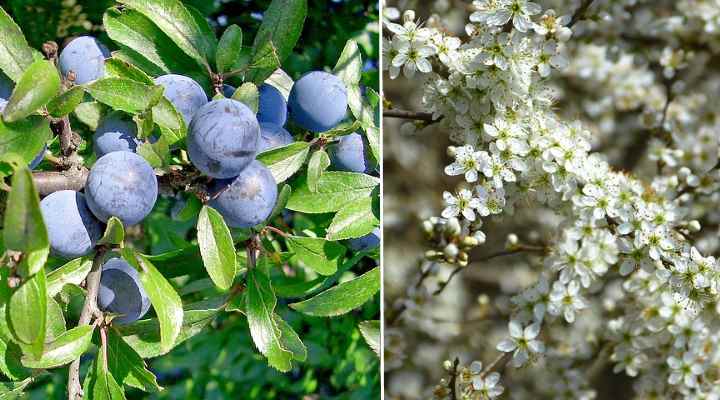
Spiked blackthorn have thorny branches and can be grown as a defensive flowering plant
Blackthorn is a large deciduous shrub with masses of sharp prickles on stiff branches to keep out unwanted guests. The jaggy shrub has elongated oval leaves and blue drupes called sloe. As an easy-care spiny landscaping shrub, the spiky blackthorn branches are ideal for garden security. The bushy shrub grows up to 16 ft. (5 m) tall and wide.
Identify the blackthorn shrub by its narrow oval leaves 0.8” – 1.7” (2 – 4.5 cm) long, creamy-white flowers with five petals and purple-blue berry-like drupes that look like blueberries.
Hardy to USDA zones 6 – 9. Grow in full sun to partial shade.
Porcupine Tomato or Devil’s Thorn (Solanum pyracanthos)
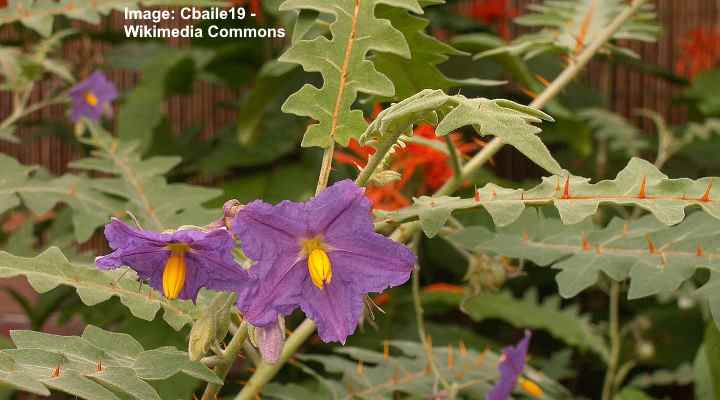
Porcupine tomato is a prickly shrub with thorny evergreen leaves and purple leaves
Also called the Devil’s thorn, the porcupine tomato shrub has evergreen leaves with menacing-looking orange thorns providing protection. The attractive feature of the porcupine tomato plant is the fuzzy gray, narrow lobed leaves, and straight bright orange thorns. Lavender-colored flowers bloom in spring, adding to the defensive plant’s ornamental appeal.
The porcupine tomato is a low-growing spiky shrub that grows 1 to 5 ft. (0.3 – 1.5 m) tall. The spiny leaves grow between 2.3” and 8” (6 – 21 cm) long. The long-blooming thorny plant produces flowers throughout the year, growing in USDA zones 9 to 11 in sun or light shade.
Identify the porcupine tomato by its long narrow, gray-green leaves with deeply lobed margins and long, sharp orange thorns growing from the leaves and stems.
Oregon Grape (Mahonia aquifolium)

Oregon grape bush has prickly leaves, yellow flowers and dark purple berries and can tolerate both sunny and shady locations
The defensive characteristic of an Oregon grape bush is its sharp, prickly leaves that look like holly leaves. Also called holly-leaved barberry or Oregon grape-holly, this medium-sized evergreen shrub grows between 3 and 6 ft. (1 – 1.8 m) tall. The grape-holly shrub also produces clusters of bright yellow flowers and dark blue-purple berries.
The Oregon grape-holly bush is perfect for growing as a decorative security hedge in shade gardens. You can also use the jaggy shrub as a foundation planting or border shrub to protect your property.
Identify Oregon grape shrubs by the glossy-green leaves with spiny margins, golden-yellow flowers, and clusters of edible blue berries.
Grow in USDA zones 5 – 8 in sun or shade.
Fuchsia-Flowered Gooseberry (Ribes speciosum)
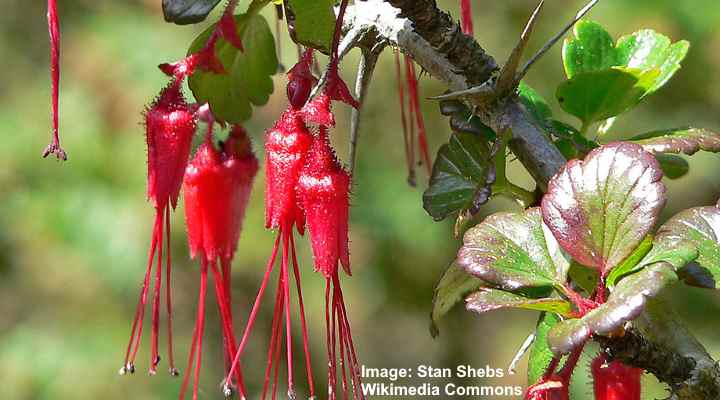
Fuchsia-flowered gooseberry have long sharp thorns at each stem node
Fuchsia-flowered gooseberry is a flowering deciduous shrub with three dangerous-looking spines at each stem node. The long, sharp, stiff spines are enough to prevent anyone—human or animal—from trying to get through the bush. Other features of the thorny fuchsia shrub are dangling red tubular flowers with long stamens and red fuzzy berries.
To use as an ornamental security plant, grow the low-maintenance fuchsia-flowered gooseberry as a foundation planting, along borders, or beside fences. Grow in USDA zones 3 to 8 in full sunlight.
Identify the fuchsia-flowered gooseberry by its three razor-sharp spines poking out from the stem nodes and crimson, fuchsia-like drooping flowers.
Barrel Cactus

Golden barrel cactus (Echinocactus grusonii) may eventually reach 3 ft. (1 m) in height
Although not a spiky bush or vine, a barrel cactus is a sizeable thorny desert plant that you can plant for security. Barrel cacti are dome-shaped plants covered in strong, stiff yellow spines. A row of barrel cacti can be an ideal security solution along borders if the ground is too dry or the climate is too hot for planting thorn bushes for security.
Related articles:
